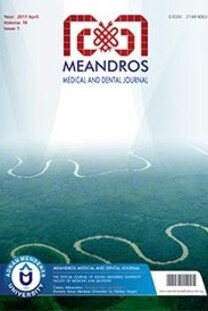Evaluation of the Knowledge and Attitudes of Dental Health Care Workers Regarding the New Coronavirus Disease-2019 Outbreak
Diş Hekimliği Sağlık Çalışanlarının Koronavirüs Hastalığı-2019 Salgınına Karşı Bilgi Düzeyi ve Davranışlarının Değerlendirilmesi
___
1. Spagnuolo G, De Vito D, Rengo S, Tatullo M. COVID-19 outbreak: An overview on dentistry. Int J Environ Res Public Health 2020; 17: 2094.2. Gorbalenya AE, Baker SC, Baric RS, Groot RJ, Drosten C, Gulyaeva AA, et al. The species Severe acute respiratory syndrome-related coronavirus: classifying 2019-nCoV and naming it SARS-CoV-2. Nat Microbiol 2020; 2: 1-9.
3. Wax RS, Christian MD. Practical recommendations for critical care and anesthesiology teams caring for novel coronavirus (2019-nCoV) patients. Can J Anaesth 2020; 67: 568-76.
4. Ather A, Patel B, Ruparel NB, Diogenes A, Hargreaves KM. Coronavirus disease 19 (COVID-19): ımplications for clinical dental care. J Endod 2020; 46: 584-95.
5. Zhu N, Zhang D, Wang W, Li X, Yang B, Song J, et al. A novel coronavirus from patients with pneumonia in China, 2019. N Engl J Med 2020; 382: 727-33.
6. Gorbalenya AE, Baker SC, Baric RS, de Groot R, Drosten G, Gulyaeva AA, et al. Severe acute respiratory syndrome-related coronavirus: The species and its viruses – a statement of the Coronavirus Study Group. bioRxiv 2020: 1-15.
7. Sohrabi C, Alsafi Z, O’Neill N, Khan M, Kerwan A, Al-Jabir A, et al. World Health Organization declares global emergency: A review of the 2019 novel coronavirus (COVID-19). Int J Surg 2020; 76: 71-6.
8. Li R, Pei S, Chen B, Song Y, Zhang T, Yang W, et al. Substantial undocumented infection facilitates the rapid dissemination of novel coronavirus (SARS-CoV-2). Science 2020; 368: 489-93.
9. Guan WJ, Ni ZY, Hu Y, Liang WH, Ou CQ, He JX, et al. Clinical characteristics of 2019 novel coronavirus infection in China. medRxiv 2020. doi:10.1101/2020.1102.1106.20020974.
10. Yang Y, Lu Q, Liu M, Wang Y, Zhang A, Jalali N, et al. Epidemiological and clinical features of the 2019 novel coronavirus outbreak in China. medRxiv 2020. doi:10.1101/2020.1102 .1110.20021675.
11. Yu T, Zhang X, Zhang L. Epidemiological and clinical characteristics of 99 cases of 2019 novel coronavirus pneumonia in Wuhan, China: a descriptive study. Lancet 2020; 395: 507-13.
12. Rothe C, Schunk M, Sothmann P, Bretzel G, Froeschl G, Wallrauch C, et al. Transmission of 2019-nCoV infection from an asymptomatic contact in Germany. N Engl J Med 2020; 382: 970-1.
13. Kohn WG, Collins AS, Cleveland JL, Harte JA, Eklund KJ, Malvitz DM. Centers for disease control and prevention (CDC). Guidelines for infection control in dental health-care settings--2003. MMWR Recomm Rep 2003; 52: 1-61.
14. Meng L, Hua F, Bian Z. Coronavirus disease 2019 (COVID-19): Emerging and future challenges for dental and oral medicine. J Dent Res 2020; 99: 481-7.
15. Li RW, Leung KW, Sun FC, Samaranayake LP. Severe acute respiratory syndrome (SARS) and the GDP. Part II: implications for GDPs. Br Dent J 2004; 197: 130-4.
16. Samaranayake LP, Peiris M. Severe acute respiratory syndrome and dentistry: a retrospective view. J Am Dent Assoc 2004; 135: 1292-302.
17. World Health Organization. Clinical management of severe acute respiratory infection when novel coronavirus (2019-nCoV) infection is suspected: interim guidance, 2020. https://www. who.int/publications-detail/clinical-management-of-severeacute-respiratory-infection-when-novel-coronavirus-(ncov)- infection-is-suspected
18. Marui VC, Souto MLS, Rovai ES, Romito GA, Chambrone L, Pannuti CM. Efficacy of preprocedural mouthrinses in the reduction of microorganisms in aerosol: A systematic review. J Am Dent Assoc 2019; 150: 1015-26.
19. Vandenberghe B, Jacobs R, Bosmans H. Modern dental imaging: a review of the current technology and clinical applications in dental practice. Eur Radiol 2010; 20: 2637-55.
20. Fatiregun AA, Olowookere SA, Oyebade AO. Pandemic Influenza A (H1N1): knowledge among senior health workers at a secondary health care institution in Southwest, Nigeria. Afr Health Sci 2011; 11: 171-5.
21. Albano L, Matuozzo A, Marinelli P, Di Giuseppe G. Knowledge, attitudes and behaviour of hospital health-care workers regarding influenza A/H1N1: A cross sectional survey. BMC Infect Dis 2014; 14: 208.
22. Khan A, Johani MA. Level of willingness to report to work during a pandemic among the emergency department health care professionals. Asian Journal of Medical Sciences 2014; 5: 58-62.
23. Qureshi K, Gershon RR, Sherman MF, Straub T, Gebbie E, McCollum M, et al. Health care workers’ ability and willingness to report to duty during catastrophic disasters. J Urban Health 2005; 82: 378-88.
24. Shapira Y, Marganitt B, Roziner I, Shochet T, Bar Y, Shemer J. Willingness of staff to report to their hospital duties following an unconventional missile attack: a state-wide survey. Isr J Med Sci 1991; 27: 704-11.
25. Keşkek ŞÖ, Erdoğan H. COVID-19: A current brief review. Acta Medica Alanya 2020; 4: 197-202.
- ISSN: 2149-9063
- Yayın Aralığı: 4
- Başlangıç: 2000
- Yayıncı: Aydın Adnan Menderes Üniversitesi
Farklı Fakültelerdeki Öğrencilerdeki Dental AnksiyeteninDeğerlendirilmesi
Elif Dilara ŞEKER, Rümeysa BALCI, Türker YÜCESOY
Cansu Gül KOCA, Merve ÜNAL, Gamze PAKEN
Inherited Rare Factor Deficiencies: Single-centre Experience
Ayşe İpek Akyüz ÜNSAL, Francisco Jose Lopes JUNIOR, Fulden CANTAŞ, İmran KURT ÖMÜRLÜ, Alparslan ÜNAL, Buket DEMİRCİ
Hasan Onur Şimşek MD, Behiç Alp AYTEKİN
101 Top-cited Dentistry Articles From Turkey: A Bibliometric Analysis
Mustafa DEMİRCİ, Ferda KARABAY, Safa TUNCER, Meriç BERKMAN, Neslihan TEKÇE
Evaluation of Dynamic Thiol/Disulphide Homeostasis in Patients with Periodontitis
Mahmure Ayşe TAYMAN, Ceylan BAL, Cemil NURAL, Meral GÜNHAN
Kadavra Dışı Yöntemlerin Tıp Öğrencilerinin Anatomi Eğitimine Etkisi
